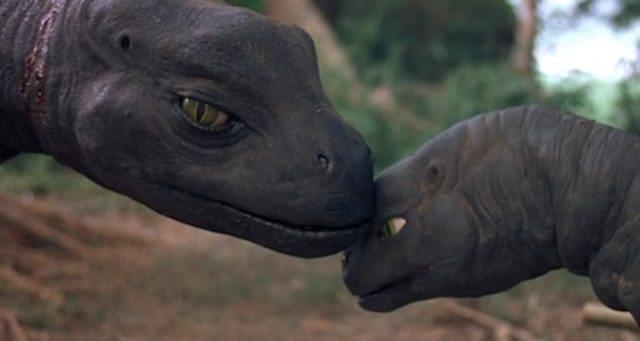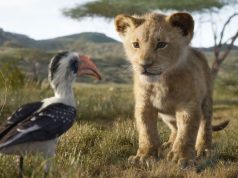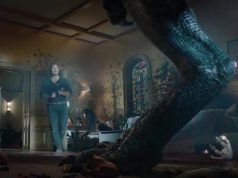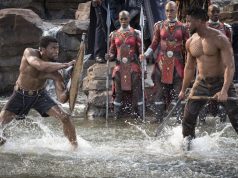
Since the beginning of cinema, filmmakers have had a keen interest in at least two things: stories about dinosaurs, and exploiting Africans. “Baby: Secret of the Lost Legend” is a 1985 exercise in both, and it finally answers the age-old question, “How cheap can we make these dinosaurs look and still expect people to watch the movie?” The answer? Slightly less cheap than this.
“Baby” comes to us from the people at Disney, who were going through a rough patch in the 1980s and decided the best way to get audiences back was to make their films look as terrible as possible. Disney distributed this film under its Touchstone banner, which gave the movie license to do things like say swear words and show naked bosoms and depict a dinosaur eating someone. It is said that upon the release of this film, the angry ghost of Walt Disney stalked the halls of his company’s headquarters and in vengeance devoured three souls.
We start in: A City! Not a specific one, just A City. There is a rather listless African culture parade shuffling down the street, apropos of nothing, and meanwhile a white business-y guy gets stabbed in an alley, perhaps also apropos of nothing. But never mind all that, because immediately the movie takes us to West Africa and acts like that stuff didn’t happen. Now we’re at a paleontological dig, where a prissy sportswriter named George (William Katt) is hanging out with his wife, Susan (Sean Young), who’s actually a paleontologist and has a good reason to be there.
Susan is not very high on the fossil-industry totem pole, so she is not taken seriously when she brings in a bone that seems to have come from a dinosaur except that it’s only a few decades old. Her elderly British boss, Eric (Patrick McGoohan), says it’s just a giraffe. Susan says, “I have the funniest feeling about this bone,” which is not something that people in movies say very often.
It turns out Eric is secretly on an expedition to look for the prehistoric creature that local legend says is living out in the jungles. People have been looking for it for years but have never found definitive proof it exists. Accompanied by his fey, mewling assistant, Nigel (Julian Fellowes) — which is what all British characters are named by default unless the screenwriter manually overrides the system — Eric secretly sets out to investigate Susan’s find.
Meanwhile, Susan learns that native tribes not too far away have been getting sick from eating meat from an animal they’d never eaten before (note to self: do not eat new animals), and thinking this might relate to the funny-feeling-inducing bone she found, she wants to go check it out. Trouble is, she and George were just about to head home to America so George could begin his new sportswriting job. They discuss whether to stay in Africa or go home; George indicates that he is unconcerned about Susan’s needs or desires and that they will head home at once; the matter is settled; Susan sneaks off without him in the middle of the night.
(I should stress that while I’m making George sound like a jerk, the movie doesn’t think he is one. He’s meant to be the male lead, the hero. He just happens to be humorless, controlling, and ineffectual, like all your best leading men.)
George chases after his wife, angrily calling her names the whole time, and is furious when he catches up with her out in the jungle. (George makes his own “George of the Jungle” reference, so I don’t have to.) But they are soon wrapped up in the matter at hand, which is that a dying man has drawn a picture of the animal he ate, and it looks like a brontosaurus. He doesn’t draw the fact that it’s dead, and that it has bites taken out of it, but you get the idea. Our heroes immediately set out to look for it — and the matter of Susan running off and George being a belligerent jerk is never addressed again.
Sure enough, they manage to find a dinosaur. And by “find,” I mean they’re just lying in their tent in a not-particularly-remote part of the jungle when a dinosaur walks past. (How is it that there were numerous failed expeditions before this one? Who were they sending? The blind and deaf?) George and Susan discover three brontosauruses, in fact, a momma dinosaur, a poppa dinosaur, and a baby dinosaur. They look a lot like the miniature models used in films! Except for when they look like animatronic puppets, I mean.
George and Susan are friends with a local tribe of Africans, the kind who carry spears and are mostly naked — you know, the National Geographic kind of Africans. But Eric and his crew have joined forces with a more civilized group of natives, by which I mean they dress in military fatigues and carry guns. It’s the latter group who kill daddy dino and capture mommy dino while George and Susan are off playing with baby dino in the forest. George, our hero, in a rare moment of actual attempted heroism, tries to intervene, and he is laid out by a soldier with a single karate chop to the neck. George will never again try to do anything.
The rest of the film consists of Eric and his bad guys trying to transport a tranquilized adult female brontosaurus through the jungle and back to civilization so Eric can study it, while George and Susan keep the baby dino with them, like a pet, and try to rescue its momma from her captors. The whole scenario lends itself readily to spectacular failure for everyone involved, and I’m pleased to note that all parties take full advantage of this. On Eric’s side of things, they’re faced with the fact that giving the dinosaur too much sedative will kill it, while allowing the sedative to wear off will allow it to wake up, break free from the ropes, and slay them all.
For George and Susan’s part, their difficulties arise from incompetence, apathy, and general ill-suitedness for the tasks at hand. At one point they take a break from running for their lives and thwarting evildoers to engage in sexual congress on the grassy jungle floor. The baby dinosaur, whom they call “Baby,” playfully interrupts them, as tykes are wont to do, and they shoo her away. Then, when they are finished, they are alarmed to discover that Baby is nowhere to be found. In summary: the dinosaur pestered them; they told it to go away; it went away; then they were concerned about the fact that it had gone away. Our heroes, ladies and gentlemen.
What strikes me most about the film is how boring it is. All of the human characters are dull, petulant, and unappealing, and the dinosaurs are barely convincing as Muppets, let alone as actual dinosaurs. Why do films about people traipsing into Africa looking for folkloric beasts always turn out so lousy? Are such adventures not inherently rife with thrilling possibilities? You would think they were. Then again, when the heroine says things like “I have the funniest feeling about this bone,” that’s probably a strong indication that the story will be proceeding downhill rapidly.
— Film.com





